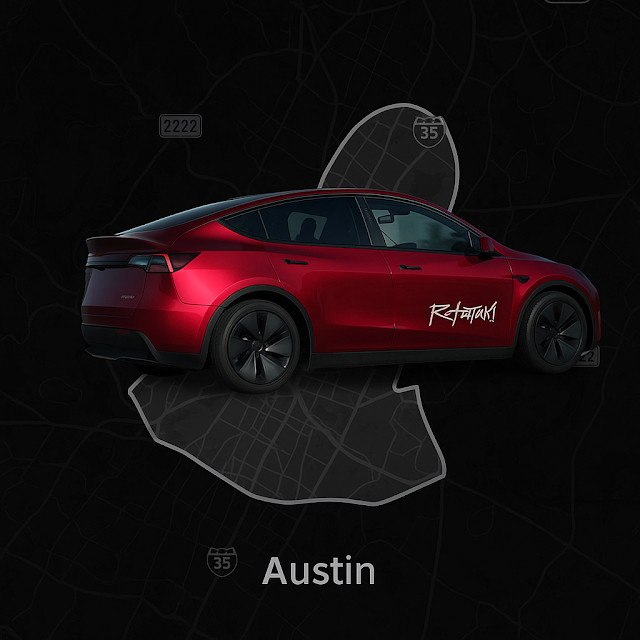Scaling Tesla's Robotaxi Service:
50% of US Population by 2025
Tesla’s Robotaxi service launched in Austin, Texas, on June 22, 2025. On the recent financial call, Elon Musk announced that robotaxi service will expand significantly in Austin, launch in the Bay Area within one to two months, and cover 50% of the US population by the end of 2025. This an ambitious scalability plan. How many cities would the service need to operate in to cover 50% of the US population?
The Austin pilot began with 10 to 20 Model Y vehicles in a 42-square-mile geofenced area, with safety monitors onboard. By July 2025, the fleet had grown to about 35 vehicles. The service relies on Tesla’s Full Self-Driving (FSD) software, using cameras and AI. The service currently charges $4.20 per ride and is invite-only for select users.
Musk’s goal to reach 50% of the US population (approximately 170.9 million people) by year-end requires expanding to major metropolitan areas. Based on 2024 Census Bureau data, the top 37 metropolitan areas are home to about 171.7 million people. Musk has named Austin, the Bay Area, Phoenix, Florida (Miami/Tampa), and Nevada (Las Vegas) as targets, with more cities planned. The top 5 areas likely to be included, based on population and Musk’s statements, are:
- New York-Newark-Jersey City, NY-NJ-PA (19.6 million): The largest US metro area, critical for population coverage.
- Los Angeles-Long Beach-Anaheim, CA (13.3 million): A key West Coast hub, complementing the Bay Area.
- Chicago-Naperville-Elgin, IL-IN-WI (9.9 million): A major Midwest market with high urban density.
- Dallas-Fort Worth-Arlington, TX (8.1 million): A Texas expansion alongside Austin, leveraging permissive regulations.
- San Francisco-Oakland-Berkeley, CA (4.6 million): The Bay Area, explicitly named by Musk for near-term launch.
To cover 50% of the US population, Tesla would need to operate in approximately 37 metropolitan areas. Tesla’s generalized FSD approach is designed to adapt without city-specific mapping. Rapid deployment is possible since this method doesn't require detailed high def maps. Musk predicts over 1,000 Cybercabs in Austin by 2026, leveraging Tesla’s manufacturing capacity.
However, challenges persist. Videos show Austin robotaxis making errors, like veering into oncoming lanes, and a July 2025 incident involved a safety driver averting a train collision. Regulatory hurdles, like Texas’s September 2025 autonomous vehicle law and California’s strict permitting process, could delay expansion. Tesla’s current reliance on teleoperators limits cost efficiency, and achieving a 100:1 vehicle-to-supervisor ratio demands further software advancements.
Ride costs of $0.25 to $0.40 per mile could disrupt ride-hailing and reduce emissions. Success hinges on overcoming safety, regulatory, and trust barriers.
Wrapping Up
| Metropolitan Area | |
|---|---|
| 1 | Austin-Round Rock-Georgetown, TX: 2,368,947 |
| 2 | San Francisco-Oakland-Berkeley, CA: 4,579,599 |
| 3 | New York-Newark-Jersey City, NY-NJ-PA: 19,641,225 |
| 4 | Los Angeles-Long Beach-Anaheim, CA: 13,288,904 |
| 5 | Chicago-Naperville-Elgin, IL-IN-WI: 9,879,320 |
| 6 | Dallas-Fort Worth-Arlington, TX: 8,100,037 |
| 7 | Houston-The Woodlands-Sugar Land, TX: 7,510,246 |
| 8 | Washington-Arlington-Alexandria, DC-VA-MD-WV: 6,432,346 |
| 9 | Miami-Fort Lauderdale-Pompano Beach, FL: 6,183,199 |
| 10 | Philadelphia-Camden-Wilmington, PA-NJ-DE-MD: 6,268,536 |
| 11 | Atlanta-Sandy Springs-Alpharetta, GA: 6,345,112 |
| 12 | Phoenix-Mesa-Chandler, AZ: 5,070,110 |
| 13 | Boston-Cambridge-Newton, MA-NH: 4,919,294 |
| 14 | Riverside-San Bernardino-Ontario, CA: 4,485,498 |
| 15 | Detroit-Warren-Dearborn, MI: 4,365,250 |
| 16 | Seattle-Tacoma-Bellevue, WA: 4,044,837 |
| 17 | Minneapolis-St. Paul-Bloomington, MN-WI: 3,706,478 |
| 18 | San Diego-Chula Vista-Carlsbad, CA: 3,298,634 |
| 19 | Tampa-St. Petersburg-Clearwater, FL: 3,342,048 |
| 20 | Denver-Aurora-Lakewood, CO: 3,005,131 |
| 21 | St. Louis, MO-IL: 2,818,249 |
| 22 | Baltimore-Columbia-Towson, MD: 2,848,104 |
| 23 | Charlotte-Concord-Gastonia, NC-SC: 2,805,115 |
| 24 | Orlando-Kissimmee-Sanford, FL: 2,817,933 |
| 25 | San Antonio-New Braunfels, TX: 2,703,378 |
| 26 | Portland-Vancouver-Hillsboro, OR-WA: 2,510,352 |
| 27 | Sacramento-Roseville-Folsom, CA: 2,428,209 |
| 28 | Pittsburgh, PA: 2,346,747 |
| 29 | Las Vegas-Henderson-North Las Vegas, NV: 2,336,989 |
| 30 | Cincinnati, OH-KY-IN: 2,288,614 |
| 31 | Kansas City, MO-KS: 2,221,297 |
| 32 | Columbus, OH: 2,180,271 |
| 33 | Indianapolis-Carmel-Anderson, IN: 2,142,193 |
| 34 | Cleveland-Elyria, OH: 2,030,305 |
| 35 | Nashville-Davidson-Murfreesboro-Franklin, TN: 2,104,235 |
| 36 | Virginia Beach-Norfolk-Newport News, VA-NC: 1,854,876 |
| 37 | Jacksonville, FL: 1,713,432 |

No comments:
Post a Comment